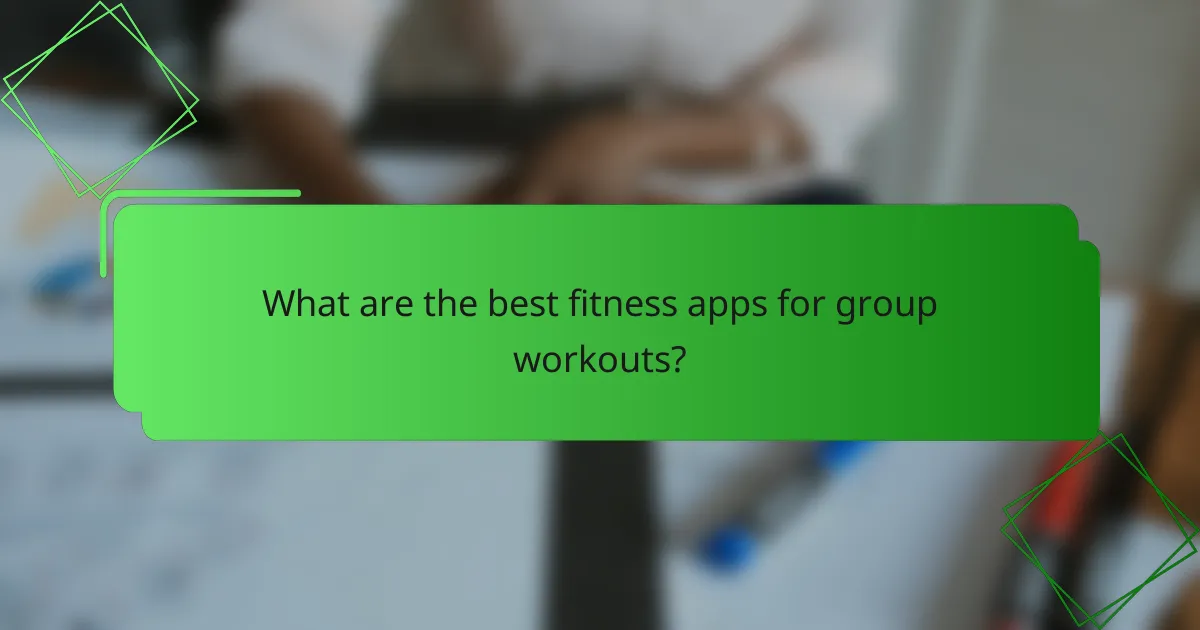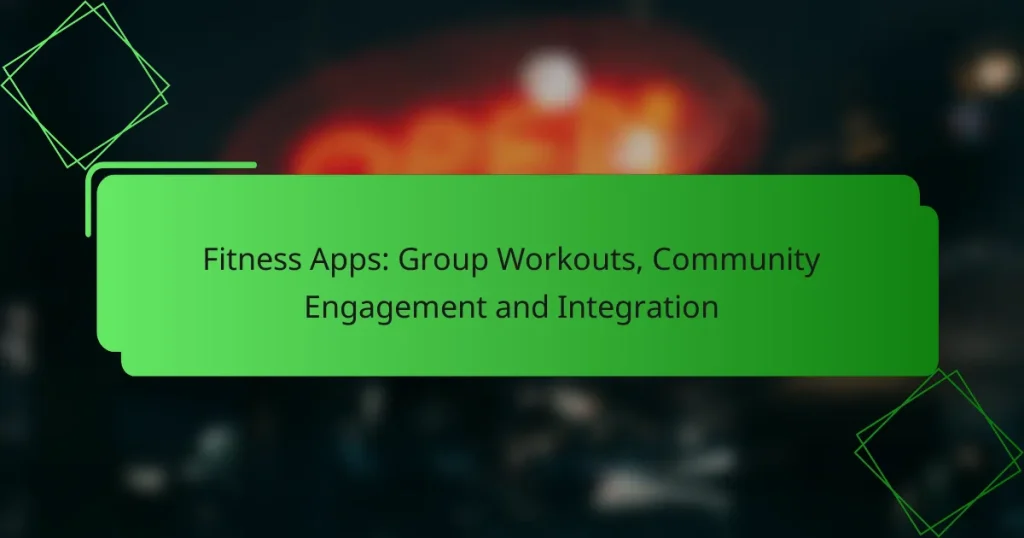Fitness apps designed for group workouts offer users a unique opportunity to collaborate and stay motivated through shared experiences. By incorporating features like live classes and community challenges, these platforms foster a sense of belonging and encourage user interaction. Additionally, they provide essential tools for tracking progress and integrating with wearables, enhancing the overall fitness journey.

What are the best fitness apps for group workouts?
The best fitness apps for group workouts facilitate collaboration and motivation among users, allowing them to engage in shared fitness experiences. These apps often include features such as live classes, community challenges, and social networking to enhance user interaction.
Peloton
Peloton is renowned for its immersive group workout experience, offering live and on-demand classes across various fitness disciplines, including cycling, running, and strength training. Users can join classes with friends or compete on leaderboards, fostering a sense of community.
Consider subscribing to Peloton’s membership for full access to its extensive library of classes and community features. The app also allows users to track their progress and set personal goals, enhancing motivation.
Fitbit
Fitbit offers a comprehensive fitness app that integrates with its wearable devices, allowing users to participate in group challenges and share achievements with friends. The app tracks various metrics, such as steps, heart rate, and calories burned, which can be compared among group members.
Joining challenges can boost motivation and accountability. Users should regularly check the community section for new challenges and opportunities to connect with others, maximizing their fitness journey.
Strava
Strava is popular among runners and cyclists for its social networking features that allow users to share their workouts and achievements. The app includes group challenges, segment competitions, and the ability to follow friends, creating a supportive environment for fitness enthusiasts.
To get the most out of Strava, consider joining local clubs or participating in virtual events. This can enhance your experience and provide additional motivation through community engagement.
MyFitnessPal
MyFitnessPal focuses on nutrition tracking but also includes features for group workouts through its community forums and challenges. Users can connect with friends to share meal plans, workout routines, and progress updates, fostering a collaborative approach to fitness.
Utilizing the app’s social features can help maintain accountability. Users should engage with the community by sharing tips and participating in discussions, which can enhance their overall fitness journey.
ClassPass
ClassPass provides access to a variety of fitness classes at local studios, allowing users to join group workouts in-person or virtually. The app offers flexibility in trying different types of classes, from yoga to high-intensity interval training, catering to diverse fitness preferences.
To maximize ClassPass, explore different studios and classes to find what works best for you. Keep an eye on promotional offers, as they can provide significant savings on class packages, making group workouts more accessible.

How do fitness apps enhance community engagement?
Fitness apps enhance community engagement by providing platforms for users to connect, motivate each other, and share their fitness journeys. These apps foster a sense of belonging through various interactive features that encourage participation and collaboration among users.
Social sharing features
Social sharing features allow users to post their workouts, achievements, and progress on social media or within the app’s community. This visibility can inspire others and create a supportive environment where users celebrate each other’s successes. Many apps integrate with platforms like Facebook and Instagram, making it easy to share milestones.
When using social sharing, consider privacy settings to control who sees your posts. Engaging with comments and feedback can also enhance connections within the community.
Challenges and competitions
Challenges and competitions are effective ways to boost motivation and engagement among users. Many fitness apps offer structured challenges, such as step counts or workout streaks, where users can compete against friends or the broader community. These competitions often come with rewards, such as badges or discounts, which can further incentivize participation.
To maximize the benefits of challenges, choose ones that align with your fitness goals and encourage friendly rivalry. Be mindful of your limits to avoid burnout or injury while participating.
In-app messaging
In-app messaging features enable users to communicate directly with friends or community members. This functionality can facilitate encouragement, advice, and accountability, making it easier to stay committed to fitness goals. Users can share tips, arrange workout sessions, or simply check in on each other’s progress.
To make the most of in-app messaging, engage regularly with your contacts and offer support. Avoid overwhelming others with messages; instead, focus on meaningful interactions that foster connection.
Virtual meetups
Virtual meetups allow users to participate in group workouts or discussions from the comfort of their homes. Many fitness apps host live classes or events where users can join in real-time, creating a shared experience that enhances community ties. These meetups can range from yoga sessions to high-intensity interval training (HIIT) classes.
When participating in virtual meetups, ensure you have a stable internet connection and a suitable space for workouts. Engaging actively during these sessions can help build relationships and enhance your fitness journey.

What are the key features of fitness apps?
Fitness apps typically include essential features that enhance user experience and engagement, such as workout tracking, progress monitoring, personalized plans, and integration with wearables. These functionalities help users stay motivated and achieve their fitness goals more effectively.
Workout tracking
Workout tracking allows users to log their exercises, sets, reps, and durations. This feature helps individuals understand their workout habits and make necessary adjustments to improve performance. Many apps offer options to categorize workouts by type, such as strength training, cardio, or flexibility exercises.
When choosing a fitness app, consider how user-friendly the workout tracking interface is. Look for apps that allow for quick entry and provide visual representations of your workout history, making it easier to identify trends over time.
Progress monitoring
Progress monitoring features enable users to visualize their fitness journey through metrics such as weight loss, muscle gain, or endurance improvements. Many apps provide graphs and charts that illustrate changes over time, helping users stay motivated and accountable.
To maximize the benefits of progress monitoring, set realistic goals and regularly update your metrics. Avoid focusing solely on weight; consider tracking other indicators of fitness, such as body measurements or performance benchmarks.
Personalized plans
Personalized plans tailor workouts and nutrition advice to individual user needs, preferences, and goals. These plans often consider factors like fitness level, available equipment, and time constraints, ensuring a more effective and engaging experience.
When selecting a fitness app, look for those that offer customizable plans. This flexibility allows users to adapt their routines as they progress, ensuring continued challenge and growth.
Integration with wearables
Integration with wearables allows fitness apps to sync data from devices like smartwatches and fitness trackers. This connectivity provides a comprehensive view of your activity levels, heart rate, and calories burned, enhancing the overall fitness experience.
Choose fitness apps that support a wide range of wearables to ensure compatibility with your devices. This integration can streamline data collection and provide deeper insights into your fitness patterns, helping you make informed decisions about your workouts.

How do fitness apps integrate with other platforms?
Fitness apps integrate with other platforms to enhance user experience and provide comprehensive health tracking. This integration allows users to sync their workout data, monitor progress, and engage with community features across various devices and applications.
Apple Health integration
Fitness apps that integrate with Apple Health can access and share health data seamlessly across iOS devices. This allows users to consolidate their fitness metrics, such as steps taken, calories burned, and workout durations, into one central hub.
To enable Apple Health integration, users typically need to grant permission within the fitness app settings. Once connected, data syncs automatically, providing a holistic view of health and fitness progress.
Google Fit compatibility
Google Fit compatibility allows fitness apps to sync data with the Google Fit platform, which is available on Android devices. This integration helps users track various health metrics, including heart rate, activity levels, and sleep patterns.
Users can link their fitness apps to Google Fit through the app’s settings. Once linked, the app can pull in data from Google Fit and vice versa, ensuring that all fitness-related information is up-to-date and accessible.
Wearable device syncing
Many fitness apps offer syncing capabilities with wearable devices, such as smartwatches and fitness trackers. This feature enables real-time monitoring of workouts and health metrics, enhancing the overall fitness experience.
To sync a wearable device, users usually need to download the corresponding app and connect it to their fitness app. Common wearables include Fitbit, Garmin, and Apple Watch, each providing unique metrics and insights that can be integrated into the fitness app for better tracking and community engagement.

What are the pricing models for fitness apps?
Fitness apps typically utilize several pricing models, including subscription-based, one-time purchase, and freemium options. Each model has its advantages and disadvantages, affecting user access and app sustainability.
Subscription-Based Models
Subscription-based models charge users a recurring fee, often monthly or annually, for access to premium features. This model provides a steady revenue stream for developers and often includes regular updates and new content. Users can expect to pay anywhere from $5 to $30 per month, depending on the app’s offerings.
One common pitfall with subscriptions is the automatic renewal, which can lead to unexpected charges. Users should review their subscription terms and consider setting reminders for renewal dates to avoid surprises.
One-Time Purchase Models
One-time purchase models require users to pay a single fee to download the app, granting lifetime access to its features. Prices for these apps typically range from $1 to $50. This model can be appealing for users who prefer not to commit to ongoing payments.
However, one-time purchase apps may lack regular updates or new content, which can limit long-term engagement. Users should assess whether the app’s features will remain relevant over time before making a purchase.
Freemium Models
Freemium models offer basic features for free while charging for advanced functionalities. This approach allows users to try the app without financial commitment, with premium features often priced between $5 and $20 per month. It can be an effective way to attract a large user base.
Users should be cautious of the limitations of free versions, as they may not provide enough value for serious fitness enthusiasts. It’s advisable to evaluate whether the premium features justify the cost based on personal fitness goals.


